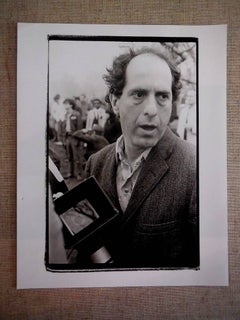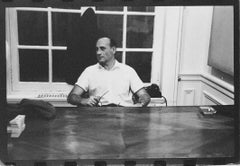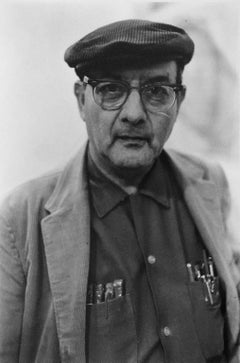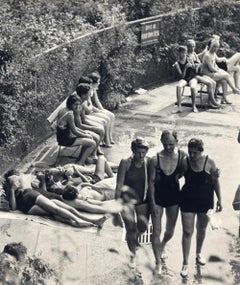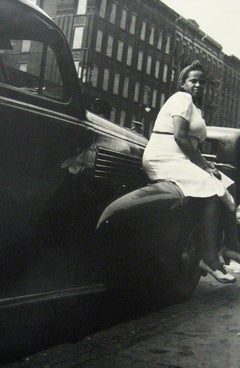Fred McDarrah Portrait Photography
to
3
Overall Width
to
Overall Height
to
3
3
2
2
1
3
48
2,265
1,337
226
210
3
Artist: Fred McDarrah
Vintage Silver Gelatin Photograph Robert Frank
By Fred McDarrah
Located in Surfside, FL
Robert Frank in Central Park. Shoot A film during Anti-War protests. April !5 1967
Robert Frank (born November 9, 1924) is an important figure in American photography and film. His m...
Category
1960s Fred McDarrah Portrait Photography
Materials
Silver Gelatin
Vintage Silver Gelatin Photograph Tibor de Nagy Portrait Photo NYC Gallery
By Fred McDarrah
Located in Surfside, FL
Tibor De Nagy - October 11 1960
Photographer is Fred McDarrah
Over a 50-year span, McDarrah documented the rise of the Beat Generation, the city’s postmodern art movement, its off-off-Broadway actors, troubadours, politicians, agitators and social protests.
Fred captured Jack Kerouac frolicking with women at a New Year’s bash in 1958, Andy Warhol adjusting a movie-camera lens in his silver-covered factory, and Bob Dylan offering a salute of recognition outside Sheridan Square near the Voice’s old office.
Not just a social chronicler, McDarrah was a great photo-journalist.
For years, McDarrah was the Voice's only photographer and, for decades, he ran the Voice’s photo department, where he helped train dozens of young photographers, including James Hamilton, Sylvia Plachy, Robin Holland...
Category
1960s American Modern Fred McDarrah Portrait Photography
Materials
Silver Gelatin
Vintage Silver Gelatin Photograph Lawrence Lipton Photo Beatnik Beat Writer
By Fred McDarrah
Located in Surfside, FL
Lawrence Lipton May 17 1965
photographer Fred McDarrah
Over a 50-year span, McDarrah documented the rise of the Beat Generation, the city’s postmod...
Category
1960s American Modern Fred McDarrah Portrait Photography
Materials
Silver Gelatin
Related Items
Coney Island
By John Albok
Located in Denton, TX
Unique
Vintage gelatin silver print
7 1/4 x 6 1/8 in.
Titled, dated, and artist stamp.
Born in Munkacs, Hungary, John Albok learned photography as a boy. He came to the U.S. in 1921...
Category
Mid-20th Century American Modern Fred McDarrah Portrait Photography
Materials
Silver Gelatin
New York City, Harlem
By Harold L. Harvey
Located in Denton, TX
Titled, dated and artist stamp.
Category
1930s American Modern Fred McDarrah Portrait Photography
Materials
Silver Gelatin
British-American Artist Malcolm Morley, signed by Jack Mitchell
By Jack Mitchell
Located in Senoia, GA
11 x 14" vintage silver gelatin photograph of British-American Artist Malcolm Morley, 2001. Signed on the print recto by Jack Mitchell. Comes directly from the Jack Mitchell Archives...
Category
Early 2000s Pop Art Fred McDarrah Portrait Photography
Materials
Silver Gelatin
$1,250 Sale Price
26% Off
H 11 in W 14 in D 0.03 in
Patsy Pulitzer, Seaplane At Palm Beach
By Slim Aarons
Located in New York, NY
Patsy Pulitzer, Seaplane At Palm Beach
Chromogenic print, 1955
Estate stamped and hand numbered edition of 150 with certificate of authenticity...
Category
1950s American Modern Fred McDarrah Portrait Photography
Materials
Silver Gelatin
Harlem, New York City
By John Albok
Located in Denton, TX
Unique
Vintage gelatin silver print
10 x 8 in.
Titled and artist stamp on verso.
Born in Munkacs, Hungary, John Albok learned photography as a boy. He came to the U.S. in 1921 findi...
Category
Mid-20th Century American Modern Fred McDarrah Portrait Photography
Materials
Silver Gelatin
Bette Davis - George Hurrell Hollywood Photograph Vintage 1940
By George Hurrell
Located in Glenford, NY
Bette Davis iconic portrait by famed Hollywood art photographer George Hurrell from 1940. It is stamped on the verso with authentic Hurrell identification.
This is a original mint ...
Category
1940s Other Art Style Fred McDarrah Portrait Photography
Materials
Silver Gelatin
$400
H 10 in W 8 in D 0.07 in
Choreographer/Director ("A Chorus Line") Michael Bennett signed by Jack Mitchell
By Jack Mitchell
Located in Senoia, GA
11 x 14" vintage silver gelatin photograph of Choreographer/Director ("A Chorus Line") Michael Bennett - 1966. Signed by Jack Mitchell on the print verso...
Category
1960s Pop Art Fred McDarrah Portrait Photography
Materials
Silver Gelatin
$1,200 Sale Price
20% Off
H 14 in W 11 in D 0.3 in
Touch of Dew: Lisa Fonssagrives, New York
By Lillian Bassman
Located in New York, NY
Gelatin silver print
Signed in pencil, verso
16 x 20 inches, sheet size
14 x 18.25 inches, image size
This artwork is offered by ClampArt, located in New York City.
Lillian Bassma...
Category
1960s American Modern Fred McDarrah Portrait Photography
Materials
Silver Gelatin
Vintage Portrait Photograph - Depth
Located in Houston, TX
Silver gelatin photograph of a close up superimposed portraits by photographer Layet, circa 1950.
Original artwork on paper displayed on a white mat with a gold border. Archival pl...
Category
1940s Fred McDarrah Portrait Photography
Materials
Paper, Silver Gelatin
Harlem (Girl with Dog in Baby Carriage) by John Albok, 1934
By John Albok
Located in Denton, TX
Harlem (Girl with Dog in Baby Carriage) by John Albok presents a young girl in a dress pushing a baby carriage down the street. A small dog sits in the carriage, looking over it's sh...
Category
Early 20th Century American Modern Fred McDarrah Portrait Photography
Materials
Silver Gelatin
$1,500
H 9.5 in W 7.5 in D 0.1 in
Composer Benjamin Britten & tenor Peter Pears, signed by Jack Mitchell
By Jack Mitchell
Located in Senoia, GA
11 x 14" vintage silver gelatin photograph of composer Benjamin Britten and tenor Peter Pears - 1969. Signed by Jack Mitchell on the print recto. Come...
Category
1960s Pop Art Fred McDarrah Portrait Photography
Materials
Silver Gelatin
$1,200 Sale Price
20% Off
H 14 in W 11 in D 0.03 in
Stage and film actor Kevin Kline
By Jack Mitchell
Located in Senoia, GA
11 x 14" vintage silver gelatin photograph of stage and film actor Kevin Kline, 1975. Comes directly from the Jack Mitchell Archives with a certificate of ...
Category
1970s Pop Art Fred McDarrah Portrait Photography
Materials
Silver Gelatin
Previously Available Items
Pres. Jimmy Carter, March 29, 1976
By Fred McDarrah
Located in Surfside, FL
Born on October 1, 1924, in Plains, Georgia, Jimmy Carter was 39th president of the United States (1977-81) and served as the nation's chief executive during a time of serious problems at home and abroad. Carter's perceived mishandling of these issues led to defeat in his bid for reelection. He later turned to diplomacy and advocacy, for which he was awarded the Nobel Prize for Peace in 2002.
---
Veteran Village Voice photographer Fred W. McDarrah
Over a 50-year span, McDarrah documented the rise of the Beat Generation, the city’s postmodern art movement, its off-off-Broadway actors, troubadours, politicians, agitators and social protests.
Fred captured Jack Kerouac frolicking with women at a New Year’s bash in 1958, Andy Warhol adjusting a movie-camera lens in his silver-covered factory, and Bob Dylan offering a salute of recognition outside Sheridan Square near the Voice’s old office.
Not just a social chronicler, McDarrah was a great photo-journalist.
For years, McDarrah was the Voice's only photographer and, for decades, he ran the Voice’s photo department, where he helped train dozens of young photographers, including James Hamilton, Sylvia Plachy, Robin Holland and Marc Asnin. His mailbox was simply marked "McPhoto."
An exhibit of McDarrah’s photos of artists...
Category
20th Century American Realist Fred McDarrah Portrait Photography
Materials
Silver Gelatin
Vintage Silver Gelatin Photograph Robert Frank
By Fred McDarrah
Located in Surfside, FL
Robert Frank in Central Park. Shoot A film during Anti-War protests. April !5 1967
Robert Frank (born November 9, 1924) is an important figure in American photography and film. His most notable work, the 1958 book titled The Americans, was influential, and earned Frank comparisons to a modern-day de Tocqueville for his fresh and nuanced outsider's view of American society. Frank later expanded into film and video and experimented with manipulating photographs and photomontage.
Frank was born in Switzerland. His father, Hermann originating from Frankfurt, Germany had become stateless after losing his German citizenship as a Jew. They had to apply for the Swiss citizenship of Frank and his older brother, Manfred. In 1946. Frank emigrated to the United States in 1947, and secured a job in New York City as a fashion photographer for Harper's Bazaar. After meeting Edward Steichen, participated in the group show 51 American Photographers at the Museum of Modern Art (MoMA)
He worked as a freelance photojournalist for magazines including McCall's, Vogue, and Fortune. Associating with other contemporary photographers such as Saul Leiter and Diane Arbus, he helped form what Jane Livingston has termed The New York School of photographers during the 1940s and 1950s.
With the aid of his major artistic influence, the photographer Walker Evans, Frank secured a grant from the John Simon Guggenheim Memorial Foundation in 1955 to travel across the United States and photograph all strata of its society. Cities he visited included Detroit, Michigan; Savannah, Georgia; Miami Beach and St. Petersburg, Florida; New Orleans, Louisiana; Houston, Texas; Los Angeles, California; Reno, Nevada; Salt Lake City, Utah; Butte, Montana; and Chicago, Illinois.
Shortly after returning to New York in 1957, Frank met Beat writer Jack Kerouac on the sidewalk outside a party and showed him the photographs from his travels. Kerouac immediately told Frank "Sure I can write something about these pictures," and he contributed the introduction to the U.S. edition of The Americans. Frank also became lifelong friends with Allen Ginsberg, and was one of the main visual artists to document the Beat subculture Les Américains was first published in 1958 by Robert Delpire in Paris, and finally in 1959 in the United States by Grove Press, where it initially received substantial criticism. The Americans became a seminal work in American photography and art history, and is the work with which Frank is most clearly identified. In 1961, Frank received his first individual show, entitled Robert Frank: Photographer, at the Art Institute of Chicago. He also showed at MoMA in New York in 1962.
A celebratory exhibit of The Americans was displayed in 2009 at the National Gallery of Art in Washington D.C., the San Francisco Museum of Modern Art, and at the Metropolitan Museum of Art in New York.
By the time The Americans was published in the United States, Frank had moved away from photography to concentrate on filmmaking. Among his films was the 1959 Pull My Daisy, which was written and narrated by Kerouac and starred Ginsberg, Gregory Corso and others from the Beat circle. The Beats emphasized spontaneity, and the film conveyed the quality of having been thrown together or even improvised.
In 1960, Frank was staying in Pop artist George Segal's basement while filming Sin of Jesus with a grant from Walter K...
Category
1960s Fred McDarrah Portrait Photography
Materials
Silver Gelatin
Vintage Silver Gelatin Photograph Lawrence Lipton Photo Beatnik Beat Writer
By Fred McDarrah
Located in Surfside, FL
Lawrence Lipton May 17 1965
photographer Fred McDarrah
Over a 50-year span, McDarrah documented the rise of the Beat Generation, the city’s postmod...
Category
1960s American Modern Fred McDarrah Portrait Photography
Materials
Silver Gelatin
Vintage Silver Gelatin Photograph Tibor de Nagy Portrait Photo NYC Gallery
By Fred McDarrah
Located in Surfside, FL
Tibor De Nagy - October 11 1960
Photographer is Fred McDarrah
Over a 50-year span, McDarrah documented the rise of the Beat Generation, the city’s postmodern art movement, its off-off-Broadway actors, troubadours, politicians, agitators and social protests.
Fred captured Jack Kerouac frolicking with women at a New Year’s bash in 1958, Andy Warhol adjusting a movie-camera lens in his silver-covered factory, and Bob Dylan offering a salute of recognition outside Sheridan Square near the Voice’s old office.
Not just a social chronicler, McDarrah was a great photo-journalist.
For years, McDarrah was the Voice's only photographer and, for decades, he ran the Voice’s photo department, where he helped train dozens of young photographers, including James Hamilton, Sylvia Plachy, Robin Holland and Marc Asnin. His mailbox was simply marked "McPhoto."
An exhibit of McDarrah’s photos of artists presented by the Steven Kasher Gallery in Chelsea was hailed by The New York Times as “a visual encyclopedia of the era’s cultural scene.”
artists in their studios, (Alice Neel, Philip Guston, Stuart Davis, Robert Smithson, Jasper Johns, Franz Kline), actors (Dustin Hoffman, Robert De Niro on the set of “Taxi Driver”), musicians (Janis Joplin, Alice Cooper, Bob Dylan) and documentary images of early happenings and performances (Yayoi Kusama, Charlotte Moorman, Al Hansen, Jim Dine, Nam June Paik). The many images of Andy Warhol include the well-known one with his Brillo boxes at the Stable Gallery in 1964. Woody Allen, Diane Arbus, W. H. Auden, Francis Bacon, Joan Baez, Louise Bourgeois, David Bowie, Jimmy Breslin, William Burroughs, John Cage, Leo Castelli, Christo, Leonard Cohen, Merce Cunningham, William de Kooning, Jim Dine, Mark di Suvero, Marcel Duchamp, Bob Dylan, Federico Fellini, Allen Ginsberg, Robert Indiana, Mick Jagger, Jasper Johns, Kusama, John Lennon, Sol Lewitt, Roy Lichtenstein, Nam June Paik, Elvis Presley, Claes Oldenburg, Yoko Ono, Robert Rauschenberg, Lou Reed, James Rosenquist, Mark Rothko, Ed Ruscha, Robert Smithson, Susan Sontag, Andy Warhol, and others.
McDarrah’s prints have been collected in depth by the J. Paul Getty Museum and the National Portrait Gallery, Washington. His work is in numerous public and private collections.
Tibor de Nagy founded an eponymous Gallery involved in the discovery of many of the Second Generation Abstract Expressionist Movement artists and also representational artists of the era including Nell Blaine, Grace Hartigan, Alfred Leslie, Helen Frankenthaler, Jane Freilicher, Paul Georges, Red Grooms, Ian Hornak, Kenneth Noland, Fairfield Porter and Larry Rivers and established emerging artists including Carl Andre, Helen Frankenthaler, Jane Wilson...
Category
1960s American Modern Fred McDarrah Portrait Photography
Materials
Silver Gelatin
Vintage Silver Gelatin Photograph Robert Frank
By Fred McDarrah
Located in Surfside, FL
Robert Frank in Central Park. Shoot A film during Anti-War protests. April !5 1967
Robert Frank (born November 9, 1924) is an important figure in American photography and film. His most notable work, the 1958 book titled The Americans, was influential, and earned Frank comparisons to a modern-day de Tocqueville for his fresh and nuanced outsider's view of American society. Frank later expanded into film and video and experimented with manipulating photographs and photomontage.
Frank was born in Switzerland. His father, Hermann originating from Frankfurt, Germany had become stateless after losing his German citizenship as a Jew. They had to apply for the Swiss citizenship of Frank and his older brother, Manfred. In 1946. Frank emigrated to the United States in 1947, and secured a job in New York City as a fashion photographer for Harper's Bazaar. After meeting Edward Steichen, participated in the group show 51 American Photographers at the Museum of Modern Art (MoMA)
He worked as a freelance photojournalist for magazines including McCall's, Vogue, and Fortune. Associating with other contemporary photographers such as Saul Leiter and Diane Arbus, he helped form what Jane Livingston has termed The New York School of photographers during the 1940s and 1950s.
With the aid of his major artistic influence, the photographer Walker Evans, Frank secured a grant from the John Simon Guggenheim Memorial Foundation in 1955 to travel across the United States and photograph all strata of its society. Cities he visited included Detroit, Michigan; Savannah, Georgia; Miami Beach and St. Petersburg, Florida; New Orleans, Louisiana; Houston, Texas; Los Angeles, California; Reno, Nevada; Salt Lake City, Utah; Butte, Montana; and Chicago, Illinois.
Shortly after returning to New York in 1957, Frank met Beat writer Jack Kerouac on the sidewalk outside a party and showed him the photographs from his travels. Kerouac immediately told Frank "Sure I can write something about these pictures," and he contributed the introduction to the U.S. edition of The Americans. Frank also became lifelong friends with Allen Ginsberg, and was one of the main visual artists to document the Beat subculture Les Américains was first published in 1958 by Robert Delpire in Paris, and finally in 1959 in the United States by Grove Press, where it initially received substantial criticism. The Americans became a seminal work in American photography and art history, and is the work with which Frank is most clearly identified. In 1961, Frank received his first individual show, entitled Robert Frank: Photographer, at the Art Institute of Chicago. He also showed at MoMA in New York in 1962.
A celebratory exhibit of The Americans was displayed in 2009 at the National Gallery of Art in Washington D.C., the San Francisco Museum of Modern Art, and at the Metropolitan Museum of Art in New York.
By the time The Americans was published in the United States, Frank had moved away from photography to concentrate on filmmaking. Among his films was the 1959 Pull My Daisy, which was written and narrated by Kerouac and starred Ginsberg, Gregory Corso and others from the Beat circle. The Beats emphasized spontaneity, and the film conveyed the quality of having been thrown together or even improvised.
In 1960, Frank was staying in Pop artist George Segal's basement while filming Sin of Jesus with a grant from Walter K...
Category
1960s Fred McDarrah Portrait Photography
Materials
Silver Gelatin
Fred Mcdarrah portrait photography for sale on 1stDibs.
Find a wide variety of authentic Fred McDarrah portrait photography available for sale on 1stDibs. You can also browse by medium to find art by Fred McDarrah in silver gelatin print and more. Much of the original work by this artist or collective was created during the 1960s and is mostly associated with the modern style. Not every interior allows for large Fred McDarrah portrait photography, so small editions measuring 8 inches across are available. Customers who are interested in this artist might also find the work of Lillian Bassman, William Klein, and John Albok. Fred McDarrah portrait photography prices can differ depending upon medium, time period and other attributes. On 1stDibs, the price for these items starts at $1,100 and tops out at $1,800, while the average work can sell for $1,600.
